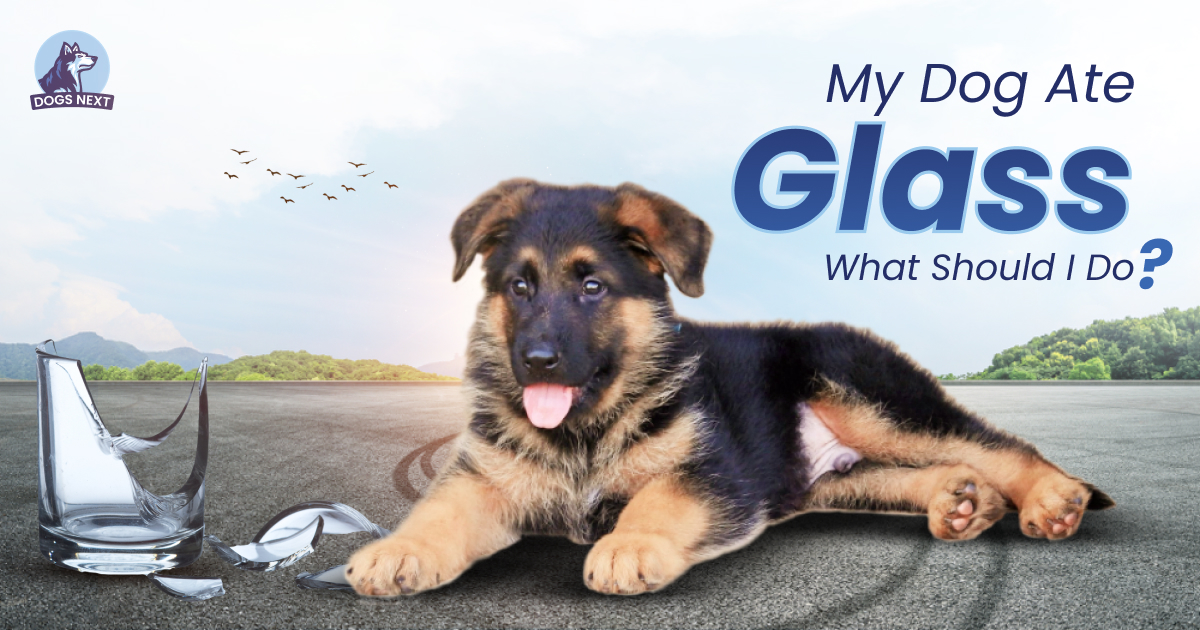If your dog has eaten glass, it can be a serious and potentially life-threatening situation. Glass can cause internal injuries, such as cuts, punctures, internal damage, and tears, to the dog’s mouth, throat, stomach, and intestines. These injuries can lead to internal bleeding, infection, blockage, and a painful abdomen which can be fatal if left untreated.
If you have ever experienced the loss of a dog due to eating glass, you know how devastating it can be. That’s why it’s crucial to take preventive measures and know what to do in case of an emergency.
In this article, we will share some essential tips to protect your dog from the danger of eating glass or pieces of glass, including warning signs, gastrointestinal tract, prevention strategies, and emergency actions.
Table of Contents
What Happens If a Dog Eats Glass?
The symptoms of a dog who has eaten glass can vary depending on the severity of the injury and the location of the glass pieces inside the body. Some common symptoms include vomiting, diarrhea, loss of appetite, lethargy, abdominal pain, difficulty breathing, coughing, gagging, bleeding from the mouth or rectum, and signs of shock.
If you suspect that your dog has eaten glass, it’s important to act quickly and seek veterinary care immediately. Your vet may perform a physical exam, blood tests, x-rays, or other diagnostic tests to locate the glass and assess the extent of the damage.
It’s important to note that prevention is always the best strategy when it comes to protecting your dog from eating glass and real damage!
Understanding the Dangers of Glass for Dogs
Glass is a common household item that can pose a danger to dogs. When a dog ingests glass, it can cause internal injuries that can be life-threatening.
The sharp edges of glass can cause cuts, punctures, and tears in a dog’s mouth, throat, stomach, and intestines. These injuries can lead to internal bleeding, infection, or blockage, which can be fatal if left untreated. Dogs are naturally curious animals and can easily mistake glass shards for food or chew on objects that contain glass, such as broken bottles, light bulbs, or ornaments.
Prevention is the best way to protect your dog from the dangers of glass. Make sure to keep all glass items out of reach of your dog, especially in areas where they spend time unsupervised. Regularly inspect your home and yard for any broken glass or sharp objects that could be a potential hazard to your pet.
Understanding the dangers of glass and taking preventative measures can help ensure that your furry friend stays safe and healthy. Don’t let a preventable accident lead to the loss of your beloved pet.
What To Do If a Dog Ate Pyrex Glass?
If you suspect that your dog has eaten glass, it is important to seek veterinary care immediately. Do not induce vomiting or attempt to remove the glass yourself, as this can cause further damage to your dog’s digestive tract.
Your veterinarian may perform diagnostic tests, such as X-rays or an endoscopy, to locate and remove any glass fragments. Treatment may also include medications to reduce inflammation and prevent infection.
How Would the Health of My Dog Be Compromised If He Ate Glass?
Eating glass can cause a range of health issues for dogs, depending on the size and shape of the fragments and how much was ingested. Glass can damage the mouth, throat, esophagus, stomach, and intestines, leading to pain, bleeding, and infection.
In severe cases, glass ingestion can be fatal. Signs of glass ingestion in dogs may include vomiting, diarrhea, lethargy, loss of appetite, abdominal pain, and difficulty breathing. If you suspect that your dog has eaten glass, it is important to seek veterinary care immediately.
Signs and Symptoms of Glass Ingestion
Recognizing the signs and symptoms of glass ingestion is crucial to getting your dog the necessary medical attention they need.
One of the most common signs of glass ingestion is vomiting. If you notice your dog vomiting repeatedly or bringing up blood, it may be a sign that they have ingested glass.
Other signs may include diarrhea, loss of appetite, lethargy, abdominal pain, difficulty breathing, coughing, gagging, bleeding from the mouth or rectum, and signs of shock.
Here are some signs and symptoms of glass ingestion that pet owners should be aware of:
Symptoms of glass ingestion | Vomiting, especially if it is repetitive or contains bloodDiarrheaLoss of appetite lethargy or weaknessAbdominal pain or discomfort Difficulty breathing Coughing or gaggingBleeding from the mouth or rectumSigns of shock, such as pale gums, rapid heartbeat, or collapse |
It’s important to note that not all dogs will exhibit these symptoms, and the severity can vary depending on the size and location of the glass object ingested. Some dogs may not show any symptoms until the injury has already become serious or life-threatening.
What to Do if Your Dog Eats Glass
If you suspect that your dog has ingested glass, it’s important to act quickly and seek veterinary care. Here are some steps to take if your dog eats glass:
- Contact your veterinarian immediately or an emergency animal hospital if your vet is not available. Time is of the essence, and the sooner your dog can receive medical attention, the better their chances of recovery.
- Do not attempt to induce vomiting or give your dog any food or water, as this can worsen the injury or cause further damage.
- If possible, bring the glass object or any remaining pieces with you to the vet, as this can help them determine the extent of the injury and plan appropriate treatment.
- Follow your veterinarian’s instructions for care and monitoring, including any medications or dietary changes. In some cases, surgery may be necessary to remove the glass or repair the injury.
- Take steps to prevent future incidents, such as keeping glass and other dangerous objects out of reach of your dog and supervising them closely when outside or in unfamiliar environments.
Remember that prevention is key when it comes to keeping your dog safe from glass and other hazards. By taking steps to protect your dog and seeking prompt veterinary care if an incident does occur, you can help keep your furry friend healthy and happy.
Frequently Asked Questions
Q: What happens if a dog eats a piece of glass?
Ans: If a dog eats a piece of glass, it can cause internal injuries such as cuts, tears, and punctures to the mouth, throat, stomach, and intestines. This can lead to serious complications such as infection, internal bleeding, and even death.
Q: What do I do if my dog eats a glass ornament?
Ans: If your dog eats a glass ornament, it’s important to seek veterinary care immediately. Follow your veterinarian’s instructions for care and monitoring, which may include X-rays, surgery, and medications.
Q: How long does it take a dog to pass an object?
Ans: The time it takes for a dog to pass an object depends on various factors such as the size and shape of the object, the dog’s age and health condition, and the type of food they eat. In some cases, dogs may be able to pass small objects such as pebbles or coins within a day or two, while larger or sharp objects such as glass or bones may require medical intervention.
Conclusion
Losing a beloved pet to glass ingestion is a tragic and avoidable experience. As pet owners, it’s important to understand the risks associated with glass and take steps to prevent our dogs from coming into contact with it. This includes keeping glass objects and debris out of reach and supervising our dogs closely when they are outside or in unfamiliar environments.
If you suspect that your dog has ingested glass, it’s crucial to seek veterinary care immediately. Delayed treatment can lead to serious complications or even death. Understanding the signs and symptoms of glass ingestion can help you recognize a potential problem and act quickly to get your dog the care they need.

I’m David, an expert contributor and writer, with two furry friends of my own, I know the challenges of raising and caring for dogs. From training to nutrition and health, my goal is to provide valuable insights and advice to help create strong bonds and happy, healthy lives. Find me in Twitter.




